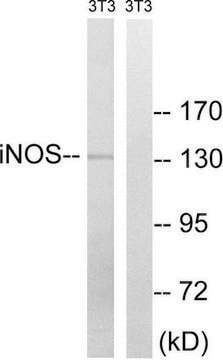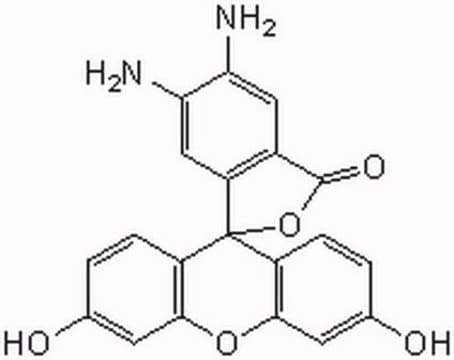MABN527
Anti-iNOS/NOS II, clone 13F5.1 Antibody
culture supernatant, clone 13F5.1, from mouse
同義詞:
Nitric oxide synthase, inducible, Hepatocyte NOS, HEP-NOS, Inducible NO synthase, Inducible NOS, iNOS, NOS type II, Peptidyl-cysteine S-nitrosylase NOS2
登入查看組織和合約定價
全部照片(3)
About This Item
分類程式碼代碼:
12352203
eCl@ss:
32160702
NACRES:
NA.41
推薦產品
生物源
mouse
品質等級
抗體表格
culture supernatant
抗體產品種類
primary antibodies
無性繁殖
13F5.1, monoclonal
物種活性
human
技術
immunohistochemistry: suitable
western blot: suitable
同型
IgG1λ
NCBI登錄號
UniProt登錄號
運輸包裝
dry ice
目標翻譯後修改
unmodified
基因資訊
human ... NOS2(4843)
一般說明
iNOS/NOS II, also known as Nitric oxide synthase inducible, Hepatocyte NOS, HEP-NOS, Inducible NO synthase, Inducible NOS, iNOS, NOS type II, Peptidyl-cysteine S-nitrosylase , and encoded by the gene name NOS2 and NOS2A, produces nitric oxide (NO) which is a messenger molecule with diverse functions throughout the body. Nitric oxide (NO) is an inorganic, gaseous free radical that carries a variety of messages between cells. Vasorelaxation, neurotransmission and cytotoxicity can all be potentiated through cellular response to NO. NO production is mediated by members of the nitric oxide synthase (NOS) family. NOS catalyzes the oxidization of L-arginine to produce L-citrulline and NO. Two constitutive isoforms, brain or neuronal NOS (b or nNOS, type I) & endothelial cell NOS (eNOS, type III), and one inducible isoform (iNOS, type II), have been cloned. Cytokines such as interferon-gamma (IFN), tumor necrosis factor (TNF), interleukin-1 and -2, and lipopolysaccarides (LPS) cause an increase in iNOS mRNA, protein, and activity levels. Protein kinase C-stimulating agents exhibit the same effect on iNOS activity. Human iNOS is regulated by calcium/calmodulin (in contrast with mouse NOS2). iNOS/NOS II is expressed in the liver, retina, bone cells and airway epithelial cells of the lung.
免疫原
GST-tagged recombinant protein corresponding to human iNOS/NOS II.
應用
Immunohistochemistry Analysis: A 1:50-250 dilution from a representative lot detected iNOS/NOS II in human cerebral cortex, human cerebellum, and human colon tissue.
Research Category
Neuroscience
Neuroscience
Research Sub Category
Developmental Signaling
Developmental Signaling
This Anti-iNOS/NOS II antibody is validated for use in WB, IH for the detection of iNOS/NOS II.
品質
Evaluated by Western Blotting in human small intestine tissue lysate.
Western Blotting Analysis: A 1:500 dilution of this antibody detected iNOS/NOS II in 10 µg of human small Intestine tissue lysate.
Western Blotting Analysis: A 1:500 dilution of this antibody detected iNOS/NOS II in 10 µg of human small Intestine tissue lysate.
標靶描述
~130 kDa observed. Uncharacterized band(s) may appear in some lysates.
外觀
Unpurified
Mouse monoclonal IgG1λ in buffer containing 0.05% sodium azide.
儲存和穩定性
Stable for 1 year at -20°C from date of receipt.
Handling Recommendations: Upon receipt and prior to removing the cap, centrifuge the vial and gently mix the solution. Aliquot into microcentrifuge tubes and store at -20°C. Avoid repeated freeze/thaw cycles, which may damage IgG and affect product performance.
Handling Recommendations: Upon receipt and prior to removing the cap, centrifuge the vial and gently mix the solution. Aliquot into microcentrifuge tubes and store at -20°C. Avoid repeated freeze/thaw cycles, which may damage IgG and affect product performance.
其他說明
Concentration: Please refer to lot specific datasheet.
免責聲明
Unless otherwise stated in our catalog or other company documentation accompanying the product(s), our products are intended for research use only and are not to be used for any other purpose, which includes but is not limited to, unauthorized commercial uses, in vitro diagnostic uses, ex vivo or in vivo therapeutic uses or any type of consumption or application to humans or animals.
Not finding the right product?
Try our 產品選擇工具.
儲存類別代碼
12 - Non Combustible Liquids
水污染物質分類(WGK)
WGK 1
閃點(°F)
Not applicable
閃點(°C)
Not applicable
分析證明 (COA)
輸入產品批次/批號來搜索 分析證明 (COA)。在產品’s標籤上找到批次和批號,寫有 ‘Lot’或‘Batch’.。
Sang Mi Park et al.
International journal of molecular medicine, 41(5), 2771-2783 (2018-02-14)
Socheongryong-Tang (SCRT) is a natural medicine prescription that has been mainly used in East Asia for the treatment of inflammatory disorders, including asthma and allergic rhinitis. The present study evaluated the anti-inflammatory effects of SCRT on lipopolysaccharide (LPS)-stimulated RAW 264.7 cells
Sonja Stojković Burić et al.
Oxidative medicine and cellular longevity, 2019, 3061607-3061607 (2019-04-16)
The main reasons for the inefficiency of standard glioblastoma (GBM) therapy are the occurrence of chemoresistance and the invasion of GBM cells into surrounding brain tissues. New therapeutic approaches obstructing these processes may provide substantial survival improvements. The purpose of
我們的科學家團隊在所有研究領域都有豐富的經驗,包括生命科學、材料科學、化學合成、色譜、分析等.
聯絡技術服務







